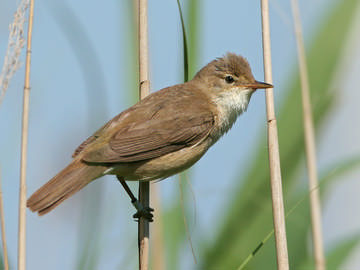Reed Warbler (Acrocephalus scirpaceus)

Reed Warbler © Steve Round
This species is appropriately-named, for the breeding map and breeding habits of the Reed Warbler are defined by Common Reed Phragmites australis. They seldom breed away from Phragmites although birds occasionally spill over to use similar plants such as Reed canary-grass Phalaris arundinacea and Reed sweet-grass Glyceria maxima. Although they are almost exclusively tied to reedbeds for their nests, they find much of their food away from the reeds, in surrounding bushy vegetation. Their conservation should be assured because there are national and local BAPs on the reedbed habitat; their emphasis, however, is on maintaining or creating reedbeds with large area: whilst this meets the habitat requirement of other species such as Bittern, Marsh Harrier and Bearded Tit, because Reed Warblers spend so much of their time outside the reedbed, the perimeter, rather than the area, is the key to conserving high populations of this species. Many reed-filled ditches or the edges of ponds hold one or two pairs, and several observers commented that tiny areas of reeds could be occupied. It was not surprising that 94% of the submitted habitat records were categories C (semi-natural grassland/ marsh), almost all of them C7 – reed swamp – or G and H3 (freshwater and estuarine).
Cheshire used to be at, or near, the north-western limit of Reed Warbler distribution in Britain, but the species is spreading to the north-west (Calvert 2005) as shown by its presence in 137 tetrads, up from 101 in the First Atlas. Their stronghold is probably the Mersey Valley, from Frodsham Marsh to Woolston, but they can be found anywhere with suitable habitat. They have increased greatly in Wirral, and remain absent from the east of Cheshire.
A Reed Warbler’s nest is a work of art, taking a week or more to build from reed leaves and fronds, and lined with reed flowers. Chicks leave the nest before they can fly, then spend about a week crawling through the undergrowth whilst being fed by their parents. This behaviour makes them one of the easiest species in which to prove breeding. Adults are noisy, with obvious alarm calls, and are easy to see perched on the reeds or an adjacent bush with their beaks stuffed with insects. It is a surprise that only just over half of tetrads holding the species furnished proof of breeding. It could be that some males sing for a while, then move on, but it is perhaps somewhat more likely that the late breeding season of this species meant that it did not coincide with the normal period for Atlas fieldwork. This is the latest of the common warblers to arrive and to breed, with adults trickling in during May and into June, and an extended breeding season lasting from early May well into August. [Malcolm Calvert has put in more time studying this species than almost anyone in Britain, and finds that about 1 in 5 Reed Warblers at Rostherne has a second brood, often dismantling the first nest to re-use the materials in building a second (Calvert 2005).]
In more south-easterly parts of Britain, the Reed Warbler is a common host for Cuckoos, but this had only been recorded twice in Cheshire before 1988, when 9 nests at Rostherne and 3 at Woolston were cuckolded that year (Calvert 1988, Smith & Norman 1988). Cuckoos were then recorded from at least four Cheshire Reed Warbler sites over the next few years, including annually at Rostherne 1988-1993 and at Woolston until 1995 and again in 1998, but Cuckoo-parasitism in the county now seems to have ceased.
As with most species with a clumped distribution, normal census methods do not work, so there are no indices of national or local population. Reed Warblers seem to have been little affected by the expansion of the Sahara and the vagaries of African rainfall, perhaps because they appear to winter farther south beyond the Sahel. There is no doubt that they have increased substantially in Cheshire and Wirral. Although many tetrads hold only one or two pairs, Reed Warblers are present at very high densities at favoured sites. The Rostherne Mere population doubled from around 40 during our First Atlas to 80 pairs in 2004. At Woolston the warbler census recorded about 20 singing males in the early 1980s and a total of 150 in 2006; although earlier arrival dates have brought more males in by the mid-May date of this annual survey, phragmites has increased enormously at the site. The 2004 CBR reported at least 551 singing males and the breeding population of Cheshire and Wirral must be at least double the First Atlas estimate of 300 pairs, and is perhaps as high as 750 or more.
Sponsored by Malcolm Calvert

